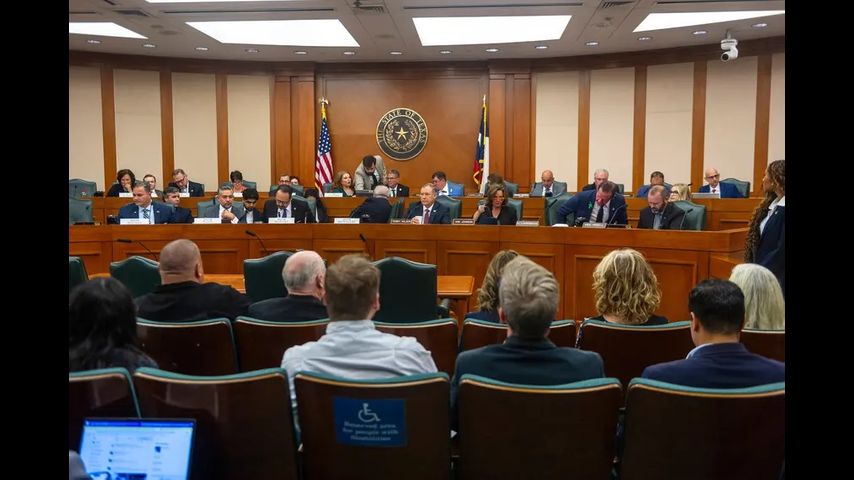Plans for flood warning system floundered before Hill Country floods, witnesses tell legislative flood committee
Sign up for The Brief, The Texas Tribune’s daily newsletter that keeps readers up to speed on the most essential Texas news.
Texas legislators on Wednesday lambasted a local river authority for a decision last year not to move ahead with pursuing a flood warning system — a decision that Republican Sen. Paul Bettencourt from Houston declared was “pathetic.”
At a joint hearing for special state House and Senate committees investigating this month’s deadly floods, the legislators considered a litany of problems with how the state responds to disasters — from a lack of minimum qualifications for local emergency management coordinators to failures in delivering weather warnings to local officials and getting first responders on the same radio communication channel.
It was the first formal discussion among lawmakers on the topic since the deadly flash flooding in Kerr County and other parts of Central Texas during the July 4 holiday weekend that killed more than 130 people, including at least 107 in Hill Country communities where summer camps host thousands of Texas kids and adults each year.
Tara Bushnoe, general manager of the Upper Guadalupe River Authority, outlined for legislators the steps that the authority took to develop a new flood warning system before pivoting their plans.
The authority submitted grant applications for a warning system in 2017 and 2018 to the state, which were denied, Bushnoe said. But when new regional flood plans were being developed, Bushnoe said they applied for state funding again in 2024.
Texas Water Development Board Executive Administrator Bryan McMath said the system the river authority wanted to build would have included detection systems at 10 low-water crossings in Kerr County that transmitted information to local agencies. TWDB was in charge of disbursing the grant funds and received many requests in so-called “Flash Flood Alley.”
In the end, Bushnoe said the river authority board declined to move forward because of the low state match for applicants’ funds. The Houston Chronicle reported on Wednesday that the river authority had found the problem worth funding before: they raised taxes by 50% in 1988 after a deadly flood to pay for a flood warning system that later fell into disrepair.
The committee members grilled the river authority about the Chronicle report showing they also had a $3.4 million reserve fund after another project that fell through.
“I find it disturbing,” Sen. Charles Schwertner, R-Georgetown, said.
Bushnoe said they had been directed by “sunset” — presumably the state Sunset Advisory Commission that reviews whether to continue state agencies or wind them down — to use some of the extra funds for their current budget.
The river authority instead worked to develop a dashboard to centralize existing data for emergency responders that legislators characterized as an example of ineffectual decisionmaking.
“I think we need [water-level] gauges not dashboards,” said Ken King, R-Canadian, the House committee’s chair.
“We are better than this”
The committee invited testimony Wednesday from a host of state agencies and river authorities involved in preparing for and responding to flooding. They heard harrowing details: An older woman rescued by a helicopter from high up on a tree branch. Food and water delivered by helicopter to stranded campers. Fish spotted in trees. A group of first responders surrounding an 8-year-old girl to pray.
Testimony also revealed that a drone that hit and forced the emergency landing of a military helicopter was an authorized search and rescue drone that flew too high and stalled, rather than an unauthorized private drone, as had been previously reported.
Legislators again considered what steps they could take to keep deadly disasters from repeating in Texas.
“Those words are going to ring in my head throughout this: We are better than this,” said Rep. Joe Moody, D-El Paso. “We’ve lost a lot in this. And it could have been better both before, during and after. We know that. And that’s not a blame game. That’s accountability, and that’s okay. That’s what we’re here to do.”
The testimony from the various state and regional officials painted a picture of longstanding problems that the state and its agencies have repeatedly failed to address, such as communication challenges and keeping drivers out of flooded roads. They discussed a lack of warning as a disaster unfolds from state officials to local leaders who are responsible for calling for evacuations and who might not be adequately trained or receive notice of a disaster in time to save lives.
The deadliest of the weekend floods, which killed at least 107 people in Kerr County, struck in the early morning hours of July 4 when most people were asleep. It’s still unclear whether many local officials saw the increasingly urgent National Weather Service warnings that began after 1 a.m. and continued throughout the night.
County officials did not testify at the committee hearing Wednesday, but are instead expected to speak at the next hearing about the disaster, on July 31 in Kerrville.
No system to ensure locals get urgent warnings
Legislators honed in on a lack of emergency training for local officials and lack of support for them to be sure they know what’s going on during a disaster.
Texas Division of Emergency Management Chief Nim Kidd said the state faced challenges going into the July 4 weekend because forecasters expected that flooding could happen over a huge swath of the state covering 44 counties and 35,000 square miles. The area was so big they started calling it the “belt,” he said.
At a July 3 morning briefing about the weather forecast, 468 accounts logged into the call.
The agency did get a boat squad positioned in Kerr County two days before the flood, Kidd said, and also placed a San Antonio Fire Department boat squad in Kerrville a day before the flood. A TDEM employee is also based in Kerr County.
Kidd said he himself keeps a weather radio by his bed. He said he did not get woken up the morning of the storm until 4:56 a.m., when he got the first report of people trapped on roofs.
But only mayors or county judges can mandate evacuations as a disaster unfolds. And there is no system for ensuring they are getting weather warnings, Kidd said.
“You do see the problem with that, right?” Sen. José Menéndez, D-San Antonio asked Kidd.
Kidd responded: “Senator, I do.”
Schwertner questioned whether the state needed to do more to be sure those decisionmakers were aware of bad weather in their areas. It can’t just be left to them getting a message from the National Weather Service, he said.
Schwertner likened the scenario to waking a president in a time of attack.
“That communication to the person making the call, not dissimilar to a time of war … needs to happen,” Schwertner said. “And so there seems to be a disconnect of making sure the person making the call is awake, alert and doing it.”
Emergency management officials lack training
The committee also heard testimony that local emergency management coordinators are not required to have standard qualifications to do that crucial job.
Peace officers, firefighters, and emergency medical technicians have to take specific tests to be in their roles. But under current law, county judges and mayors can appoint anyone as emergency management coordinators to assist them during disasters.
Only emergency management coordinators in counties of more than 500,000 residents are required to complete state-approved training, according to the hearing testimony. A push to get county judges to take training wound up with a loose law with no enforcement mechanism, Kidd said.
“To be an emergency manager, you need a signature [from a county judge or mayor],” Kidd said. “That needs to change.”
A 2020 report by a state-convened working group intended to provide the Legislature with recommendations on how to increase training and experience levels among local emergency coordinators. But it appeared not to have prompted any action by state lawmakers. The report proposed a minimum number of years of experience and training to be hired, as well as regular training throughout the emergency coordinator’s time on the job.
Records of that experience and training should be documented by state agencies, the report recommends.
State Sen. Lois Kolkhorst, R-Brenham, wondered what had happened in light of those recommendations and if they should be revisited.
Lawmakers discuss how to make fixes
Another problem: There are a multitude of radio systems that first responders use in the state, Kidd said. He recommended the state help local groups to connect them together especially so they can communicate at the start of a disaster.
When Kidd went to Kerrville Friday morning, for example, he said he ran into people he knew from the San Antonio Fire Department whose radios didn’t work in the area. They were using what he called some “really cheap Chinese radios” instead.
Legislators discussed other ways to improve disaster response. They talked about better managing the thousands of volunteers who showed up of their own volition to help, in some cases going onto private property and putting themselves at risk. They considered a state funding mechanism to help counties pay for projects to prepare better against storms. They wondered if the state could support local jurisdictions in implementing corrective plans following disasters.
And they turned to the question of warnings.
The Texas Department of Transportation Director of District Operations Carl Johnson said that installing a basic monitor and warning system at a low-water crossing with flashing lights or a gate that could lower to block vehicles would cost about $30,000 per installation. There are roughly 340 rural low water crossings in rural Texas, Johnson estimated, meaning it would cost $10-12 million to install the warning system for all of them.
State Rep. Armando Martinez pointed to floods in 2018, 2019, 2020 and this spring that flooded highway frontage roads and impacted emergency response and evacuation in The Rio Grande Valley. Martinez said the repeated flooding in the Valley, and lack of changes to address it adequately, made him concerned about the state’s ability to address flooding in the Hill Country.
“My concern is it’s been eight years and we still haven’t addressed this, but yet we’re coming up and talking about how well we performed and how well we did,” Martinez said. “Well you know what? This performance … doesn’t look very well to me.”
The lineup for The Texas Tribune Festival continues to grow! Be there when all-star leaders, innovators and newsmakers take the stage in downtown Austin, Nov. 13–15. The newest additions include comedian, actor and writer John Mulaney; Dallas mayor Eric Johnson; U.S. Sen. Amy Klobuchar, D-Minnesota; New York Media Editor-at-Large Kara Swisher; and U.S. Rep. Veronica Escobar, D-El Paso. Get your tickets today!
TribFest 2025 is presented by JPMorganChase.
This article originally appeared in The Texas Tribune at https://www.texastribune.org/2025/07/23/texas-hill-country-floods-legislative-committee-hearing/.
The Texas Tribune is a member-supported, nonpartisan newsroom informing and engaging Texans on state politics and policy. Learn more at texastribune.org.





